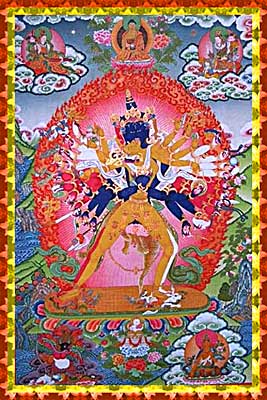Kalachakra Tantra
|
This subject has many implications that are valuable to anyone with a psychological or spiritual approach to astrology, and presents a theory of astrological interplay with the cyclic states of the everyday and supernormal levels of human consciousness. 
The Kalacakra is on of the Highest Yoga Tantras of Tibetan Buddhism. The nature of this consciousness as expressed in the Kalacakra texts is to free of the consciousness from the limitations of the cyclic nature of Time, through a transcendent type of Time termed Bliss. This tantra is divided into five chapters. The general content of the teachings of Kalacakra are usually categorized in two ways: first by [ground, path, result] and second by [external, inner, alternative]. The first chapter of the tantra deals with the physical world, in particular the calculation system for the Kalacakra calendar and the astrology that is based on that calendar. This astrology illustrates the calculation systems of the planetary motions against the background of the fixed stars of signs and constellations were outlined some 1000 years ago. b). Internal Kalacakra:The second chapter of the tantra covers the inner world of human existence, the process of gestation and birth, the classification of the functions within the human body and experience, and the expression of human physical existence in terms of channels, winds, and so forth. It is also called an 'implicit' system and deals with the astrological relationships of the internal energies, chakras, channels and drops to mental and emotional states, physical organs, and transformation processes. The theory is based on the body's subtle energies normally move in synchronicity with the cycles of the planets. This movement of planetary energies within the body is the subject of the astrology of the Internal Kalacakra. It also details the charkas, channels, and drops (microcosm) relationships with the stars, constellations and planets (macrocosm). These first two chapters are the ground Kalacakra, describing the state of human existence. c). Alternative Kalacakra:The next three chapters of the tantra describe the Alternative Kalacakra and deal with the Path and Result. The third chapter describes the entry to the meditation practices of the system, the initiation of Kalacakra. The fourth chapter explains the actual meditation practices: the meditation on the mandala and deity of Kalacakra and the perfection process of the Six Yogas. Chapters 3 and 4 thereby describe the Path of Kalacakra. Since Time, as Bliss, is the primordial sixth element of the innermost dimension of transpersonal awareness and 'internal awakening', it is important to integrate mind and body into the Primordial consciousness of the Buddha-nature, another way of defining Enlightenment in Tibetan Buddhism. In the fifth chapter, the tantra describes the state of enlightenment that results from the practice of that path, and thereby covers the Result Kalacakra. Through the higher yoga practices these cycles of circulating energy are brought under the control of yoga practitioner, who is motivated by the desire to free him/herself and develop the wisdom and compassionate powers to positively effect the world. In order to engage in the profound practices of the Complete Stage, the practitioner must become fully acquainted subtle nature of the body. The practitioner must develop knowledge of the stationery channels, the winds, or pranas, that flow within the channels, and the subtle drops that reside at specific locations within the body. Regarding the channels, the tantras generally refer to three main channels-the central channel, and the right, and left channels-as well as the five channel centers, or cakras. The three main channels then branch and re-branch throughout the body; thus, the tantric writings mention 72,000 channels, and some sutras, such as Nanda’s Entry into the Womb, mention 80,000 channels in the human body. These four types of drops are: (1). The drop at the forehead or mid-brow that becomes manifest in the waking period; (2) The drop at the throat that becomes manifest the dream state; (3) The drop at the heart that becomes manifest at the time of deep sleep; and (4) The drop at the navel that becomes manifest in the fourth stage (sexual climax). These six main chakras in human body to form the centers of psychological energy are: (1). The Crown Chakra (links to 4 channels) is the seat of pure Consciousness, the Supreme Entity. It provides a person's spiritual connection with the universe, the link with the divine. This chakra also balances the interior and exterior energies of a person's existence, linking them to the world around them. (2). The Forehead Chakra (links to 16 channels) forms the seat of both intuition and also awareness. It controls the human mind, which is itself a microcosmic replica of the Cosmic Mind. It is also known as the "third eye" located between the eyebrows. The actual chakra is located in the center of the head). (3). The Throat Chakra (links to 32 channels) coordinates all the energies of the body and controls the ethereal factors, the creativity and communication. It is at the point of the adam's apple in the neck and is responsible for speech. (4). The Heart Chakra (links to 8 channels) controls the aerial factor and is related to the respiratory and circulatory functions of the body. This chakra is located at the center of the chest and at the midpoint between the two nipples. It connects compassion and is the center of feelings of love, harmony and peace. (5). The Navel Chakra (links to 64 channels) is the seat of our life and existence. This chakra controls the luminous factor (energy, fire) and digestion. It is said to direct our awareness of self within the world. (6). The Genital Chakra (links to 32 channels) is linked to sexuality and reproductive capacity. This chakra controls the basic human survival instincts and provides an essential grounding. |
[Return] [Related links] [Six Yoga]